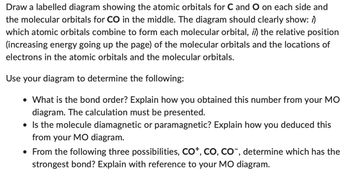
Chemistry
10th Edition
ISBN: 9781305957404
Author: Steven S. Zumdahl, Susan A. Zumdahl, Donald J. DeCoste
Publisher: Cengage Learning
expand_more
expand_more
format_list_bulleted
Question

Transcribed Image Text:Draw a labelled diagram showing the atomic orbitals for C and O on each side and
the molecular orbitals for CO in the middle. The diagram should clearly show: /)
which atomic orbitals combine to form each molecular orbital, ii) the relative position
(increasing energy going up the page) of the molecular orbitals and the locations of
electrons in the atomic orbitals and the molecular orbitals.
Use your diagram to determine the following:
• What is the bond order? Explain how you obtained this number from your MO
diagram. The calculation must be presented.
• Is the molecule diamagnetic or paramagnetic? Explain how you deduced this
from your MO diagram.
• From the following three possibilities, CO+, CO, CO-, determine which has the
strongest bond? Explain with reference to your MO diagram.
Expert Solution
This question has been solved!
Explore an expertly crafted, step-by-step solution for a thorough understanding of key concepts.
This is a popular solution
Trending nowThis is a popular solution!
Step by stepSolved in 2 steps

Knowledge Booster
Similar questions
- How can we drsw the Lewis structures for the 4 boxes? And how many charges are in Oxime?arrow_forwardWhich of the following statements about molecular orbital theory is incorrect? a) Bonding molecular orbitals result from the constructive interference of atomic orbitals. b) Antibonding molecular orbitals have higher energy than the corresponding bonding orbitals. c) Electrons in antibonding orbitals stabilize the molecule. d) The number of molecular orbitals formed equals the number of atomic orbitals combined.arrow_forwardhow does molecular orbital theory make it possible to explain both ionic and covalent bonding? The degree of ionic characters in bonding is related to electronegativity in topic 2D. How does electronegativity affect the molecular orbital diagram so that bonds become ionic?arrow_forward
- Examine the elements in the second row of the periodictable. Note that HF, H2O, NH3, and CH4all are sp3 hybridized. The first three are all capable of hydrogen bonding.Methane, on the other hand, is not capable of hydrogenbonding. Explain.arrow_forwardA benzene molecule can be modeled as six carbon atoms arrangedin a regular hexagon in a plane. At each carbon atom, one of threeradicals NH2, COOH, or OH can be attached. How many suchcompounds are possible? (Make no distinction between single anddouble bonds between the atoms.)arrow_forwardEach of the structures for ClOCl, NCOH, and ClNO has atoms connected in the order given in their formulas. Identify the type of hybridization for the central atom in each compound.arrow_forward
arrow_back_ios
arrow_forward_ios
Recommended textbooks for you
 ChemistryChemistryISBN:9781305957404Author:Steven S. Zumdahl, Susan A. Zumdahl, Donald J. DeCostePublisher:Cengage Learning
ChemistryChemistryISBN:9781305957404Author:Steven S. Zumdahl, Susan A. Zumdahl, Donald J. DeCostePublisher:Cengage Learning ChemistryChemistryISBN:9781259911156Author:Raymond Chang Dr., Jason Overby ProfessorPublisher:McGraw-Hill Education
ChemistryChemistryISBN:9781259911156Author:Raymond Chang Dr., Jason Overby ProfessorPublisher:McGraw-Hill Education Principles of Instrumental AnalysisChemistryISBN:9781305577213Author:Douglas A. Skoog, F. James Holler, Stanley R. CrouchPublisher:Cengage Learning
Principles of Instrumental AnalysisChemistryISBN:9781305577213Author:Douglas A. Skoog, F. James Holler, Stanley R. CrouchPublisher:Cengage Learning Organic ChemistryChemistryISBN:9780078021558Author:Janice Gorzynski Smith Dr.Publisher:McGraw-Hill Education
Organic ChemistryChemistryISBN:9780078021558Author:Janice Gorzynski Smith Dr.Publisher:McGraw-Hill Education Chemistry: Principles and ReactionsChemistryISBN:9781305079373Author:William L. Masterton, Cecile N. HurleyPublisher:Cengage Learning
Chemistry: Principles and ReactionsChemistryISBN:9781305079373Author:William L. Masterton, Cecile N. HurleyPublisher:Cengage Learning Elementary Principles of Chemical Processes, Bind...ChemistryISBN:9781118431221Author:Richard M. Felder, Ronald W. Rousseau, Lisa G. BullardPublisher:WILEY
Elementary Principles of Chemical Processes, Bind...ChemistryISBN:9781118431221Author:Richard M. Felder, Ronald W. Rousseau, Lisa G. BullardPublisher:WILEY

Chemistry
Chemistry
ISBN:9781305957404
Author:Steven S. Zumdahl, Susan A. Zumdahl, Donald J. DeCoste
Publisher:Cengage Learning

Chemistry
Chemistry
ISBN:9781259911156
Author:Raymond Chang Dr., Jason Overby Professor
Publisher:McGraw-Hill Education

Principles of Instrumental Analysis
Chemistry
ISBN:9781305577213
Author:Douglas A. Skoog, F. James Holler, Stanley R. Crouch
Publisher:Cengage Learning

Organic Chemistry
Chemistry
ISBN:9780078021558
Author:Janice Gorzynski Smith Dr.
Publisher:McGraw-Hill Education

Chemistry: Principles and Reactions
Chemistry
ISBN:9781305079373
Author:William L. Masterton, Cecile N. Hurley
Publisher:Cengage Learning

Elementary Principles of Chemical Processes, Bind...
Chemistry
ISBN:9781118431221
Author:Richard M. Felder, Ronald W. Rousseau, Lisa G. Bullard
Publisher:WILEY